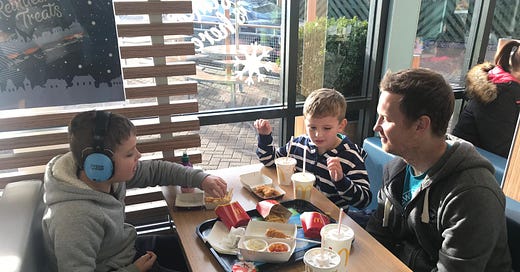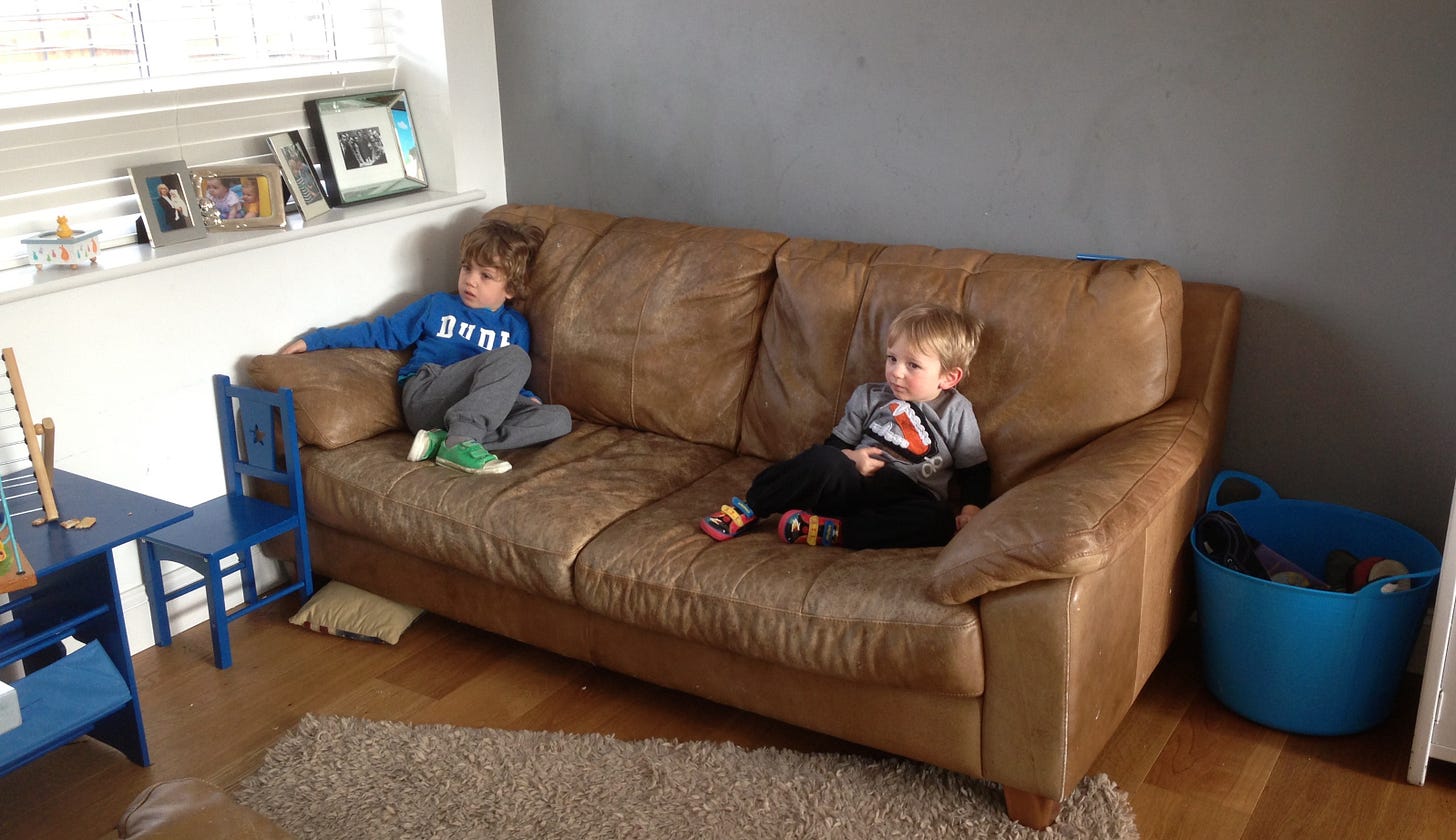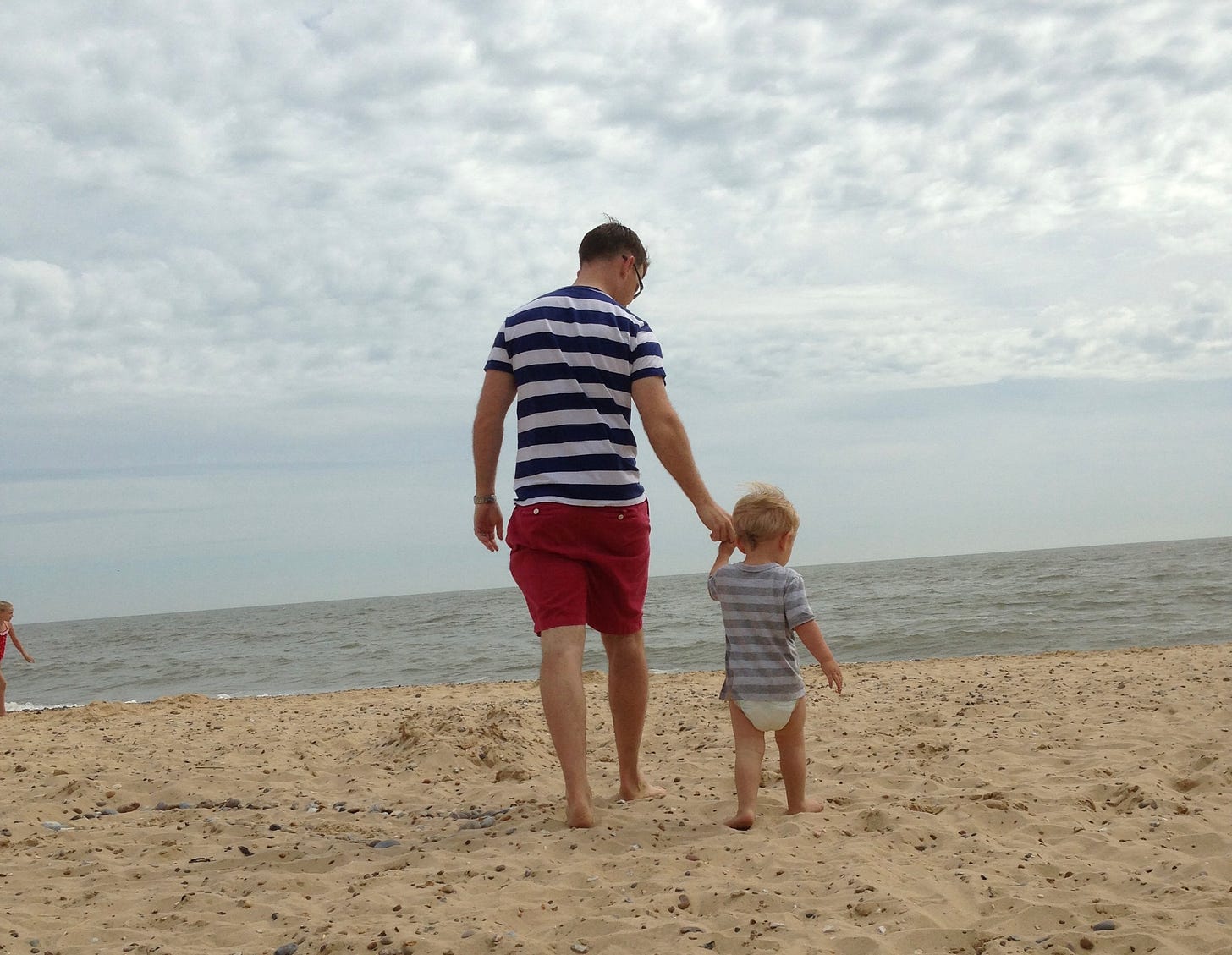If you’ve watched any of our videos online, you might not realise, that years ago, the level of interaction I had with Jude and Tommy was minimal. I receive many messages praising the bond I seem to have with my boys, and how in tune I am with them. But it wasn’t always that way.
In fact, the lack of interaction was one of the main factors that led me and their mum to seek a diagnosis for them. Both boys often seemed distant, uninterested in anything we tried to do.
It felt like they spent most of their time off in their own world…
During Jude’s first year I thought it was because I was away at work during the day. I’d get home in the evening and he’d pretty much ignore me. I thought he was punishing me for not being there.
Gradually, over the weekend, I’d make some headway. By Sunday he’d be much more comfortable with me, more open to playing. By the time I got home from work on Monday, it was like he’d forgotten all about me.
I tried to put it down to his young age. But I’d also seen how other babies’ faces would light up when one of their parents came home, how excited they were to see them. I craved that too.
Me and his mum would joke about how zoned out he was whenever he was eating in his high chair. He always wanted to look out of the window and stare at the tree as its branches swayed in the wind. We smiled at how content he was in his ‘food coma.’
As other concerns started to arise that led us down the path of an autism diagnosis (I go into more detail here) we noticed how difficult it was to engage with Jude.
Babies and toddlers are supposed to be interested in the world, aren’t they? Curious about everything? After all, everything is new to them.
And Jude was. Some of the time. But mostly he wanted to be alone, playing solo.
When Tommy came along and showed similar traits when it came to engagement, (even with such contrasting personalities) it felt like I must be doing something wrong. That they didn’t want to engage with me.
I’d been trying to learn more and more about autism by then, so had started to better understand what was behind some of their behaviours, but I was desperate to improve our bond.
I knew my boys loved me. Deep down I did. Amongst all the difficult and challenging days, there were still plenty of smiles and laughter. Yet I found it hard to get my head around why it was so fleeting. Why our interactions felt so hot and cold? Why we would have these short periods of fun together, and then much longer periods of them ignoring me.
Parents are a child’s first relationships in the world. We’re supposed to be their first teachers. The foundation blocks that enable our kids to go out into the world and bond with and learn from others.
If Jude and Tommy were so reluctant to interact with me at home, how would they be comfortable enough to learn at school from their teachers? How would their communication skills ever improve? How would they ever make a friend?
By this time Jude was already experiencing some pretty intense and distressing meltdowns. They were becoming more and more physical. I desperately wanted him to be happier. I thought if our bond was stronger, if we interacted and communicated better, and had more fun, then maybe the world wouldn’t be so overwhelming and upsetting as it was becoming for him. Maybe the bond he’d share with me and with his mum would help him feel safer. That he’d better understand that we were there to try and help him in those more difficult moments
So, we started to try something different. We attended a course called the Son-Rise programme, (which I later learned has a lot in common with Floortime therapy). There were some things that I loved about the programme and some things that I wasn’t so keen on. But I came away from there with two points fixed in my mind.
One, a much better understanding of stimming, what it is, and why it’s so important for autistic people. And two, a completely different outlook on how I should try to build that bond between me, Tommy and Jude.
From the day I got home from that course, I stopped trying to make them do what I thought they 'should' be doing. I stopped focusing on them playing with toys, looking at books, drawing, colouring, or anything else that every other 5-year-old and 2-year-old that I knew was doing. Instead, I started to join them in whatever it was they were already doing. Free of any judgment, free of any expectations.
If Jude was going around tapping the radiators I sat there with him tapping away. If Tommy was spinning round and round, I span with him. If Jude was running aimlessly up and down in the playroom, back and forth, over and over, I joined in running and jumping with him. If Tommy was ripping up paper and flicking it, I did the same.
I’ll paraphrase a little here, but I remember it being explained like this. Imagine you’re sitting on a park bench with a stranger. They love football, and all they want to talk about is football. But you have no interest in football, you love Star Wars, and all you want to talk about is Star Wars. If all you keep doing is trying to stop them talking about football and talk about Star Wars instead, then you’re going to find it hard to make a connection.
But if you showed an interest in football, listened to them, spoke about it, watched a game with them, or kicked a ball around, then that bond would grow. That stranger would come to like you, trust you, and become a friend. Then maybe, they’d be more interested too in what you wanted to talk about. What you wanted to show them
Jude and Tommy had things they loved to do, but what I had been doing was trying to make them stop doing those things, and do what I wanted them to do. An activity they didn’t understand or had no interest in doing.
Armed with this new information, every day I’d try out whatever it was that they were interested in. And slowly, but surely, things started to change.
At first, progress was minimal. When Jude was tapping the radiator I would sit down tapping the one further along the wall. After a while I’d notice him start to look up at me. Just for a few seconds, then his focus would switch back to the radiator. I was playing alongside him, with no demands or expectations. If he wanted to look over at me, I’d smile and carry on playing.
When he switched to wandering around tapping a plastic bottle, I’d grab one and join in too. When he ran back and forth and I did the same, I’d see him smiling, finding it funny that I was enjoying it like he was.
Jude never built blocks. Tommy did, but it held no interest for Jude. He would take the tub and launch them one by one down to the other end of the room. He’d then crawl after them and launch them back to where he’d come from. I started sitting at the other end of the room waiting with my own blocks. Softly throwing them back to Jude. We were playing.
It wasn’t the game that blocks were intended for. We weren’t building towers, or even knocking them down. We were throwing them back and forth. That’s the game that made the most sense and held the most interest for Jude. So that’s how we played.
Tommy always loved making puzzles, but he’d never let you join in with him. So I’d sit at the other end of the room, seemingly paying no attention, and make my own puzzles. Sometimes he’d stop me, breaking up what I was doing, and that was ok. But sometimes, he’d sit next to me and take over. Putting in missing pieces for me. He was joining in with me.
Tommy began to realise that I had my uses. When he was building blocks as high as he could, an extra pair of hands came in handy to help keep it balanced. When he was climbing on the sofa and jumping onto the crash mat we’d laid out, well sometimes it was even more fun when I picked him up and dropped him onto it instead.
Slowly, over time, we were bonding more and more. They could see that I loved doing what they loved doing. They could see that we had things in common. Which made them more open to listening when I spoke. More curious if I ever introduced something new.
Alongside that, I better understood what stimming is and what it means for Tommy and Jude. Why they both enjoyed flapping their hands, jumping, hopping, or making the same vocal sound over and over so much.
Previously, I’d tried to stop them flapping. I was scared it made them stand out. Scared of what others might say and that they’d get teased or bullied. I had a natural urge to want them to be more ‘normal.’
But they were just being themselves. And without realising it, I was trying to stop them from being that person. The more relaxed I became about stimming and the more I joined in with them, the stronger our bond became.
Fast forward ten years, and I feel like I have a really good connection with my boys. And even though they’re both non-speaking, I’m in tune with what they like and don’t like. What they need and want.
They are much more present with me than they were back then. Much more present with everyone who is close to them and a key figure in their life.
There are still times that they want to be alone, and our interactions are minimal. Just like we all need our own space at times.
They still have their preferred activities. Again, just like we all do. But their world has opened up so much more than it was when they were younger.
Joining Jude and Tommy is probably the simplest, most impactful thing I’ve done to help develop their social skills. It strengthened the bond between us and started to show them how interacting with others can be a good thing.
It helped me shift my attitude towards autism and completely changed my relationship with my boys.
It was so obvious that I couldn’t see it. They were never ignoring me, they were just waiting for me to join them ❤️







I found this with my son. He is mild ADHD and ADD
We found that out by letting him do his own thing then joining in. If he wanted to play a video game, I put the laptop on the floor so he could crawl over and sit and use. No more dragging laptops to the floor ( bad results ) by him.
We learned to go with the play flow and it was DIFFERENT for each kid.
My middle daughter was always content to be in her room playing with her stuffed animals. Setting up scenes, doing voice overs and or conversations.
She loved it and would spend hours. So I did it too, with her toys.
I became one of the voices.
Fast forward 20 years later.
My daughter is a successful Animator in the Animation Guild in Burbank and she makes children’s cartoons. She loves it. Life long dream come true. Her latest animation jobs were for Netflix & Nickelodeon.
My son is a NCAA division 1 swimmer that scholarship got him through his BA and because of the Covid innteruption, he gets to swim a 5th year.
He’s nationally ranked in just a few second away from making Olympic qualifying time.
When he was a small kid, all he wanted to do was go swimming, that culminated in an intense level in highschool. No cars, no girls, just swim, food, home work and sleep. Back up at 6 am to do it again.
2 hours of swimming before school started and after school, food, food and more FOOD and back to the pool.
They are both well balanced adults and extreme focus marks their methods ( and discipline )
Great story and good advice.
Beautiful! This is so heart-warming. I hope parents rearing children on the spectrum come across this article. I do want to mention the work of Dr. Stephen Porges, a neuroscientist, who developed a non-invasive acoustic program (Safe & Sound Protocol) that helps autistic children. It often results in reduced need for stimming and greater ability to make eye-contact and communicate.